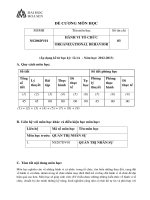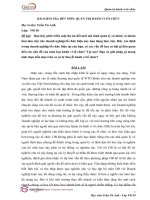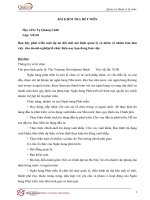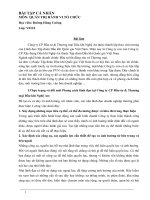Đề cương trắc nghiệm Hành Vi Tổ Chức (Organizational Behavior) CHƯƠNG 3
Bạn đang xem bản rút gọn của tài liệu. Xem và tải ngay bản đầy đủ của tài liệu tại đây (72.93 KB, 15 trang )
Chapter 3: Foundations of Employee
Motivation
3-1. Which of these is NOT a basic category of needs
identified by Maslow?
a.
Self-actualization
b.
Safety
c.
Power
d.
Esteem
e.
Belongingness
3-2. The highest level need in ERG theory is:
a.
hygienes
b.
relatedness
c.
affiliation
d.
status
e.
growth
3-3. Unlike Maslow's needs hierarchy, McClelland's learned
needs theory:
a.
does not discuss individual needs.
b.
ignores the possibility that people have a need for
social interaction.
c.
takes the view that needs are not instinctive.
d.
differs from Maslow's needs hierarchy theory in all
of the above ways.
e.
any way.
Maslow's and McClelland's theories do ot differ in
3-4. Which of these theories suggest that growth and esteem
needs represent the only source of motivation?
a.
Herzberg's Motivator-Hygiene theory
b.
Expectancy theory
c.
Maslow's Needs Hierarchy theory
d.
McClelland's Learned Needs theory
e.
Alderfer's ERG theory
3-5. An organization wants to hire someone whose main task
is to allocate scarce resources. People in this job often
experience conflict with others in the organization. The
person hired for this job should have a relatively:
a.
High need for personalized power.
b.
High need for affiliation
c.
Low need for achievement
d.
Low need for affiliation
e.
Low need for socialized power.
3-6. Which of these is a process motivation theory based on
the idea that work effort is directed toward behaviours that
people believe will lead to desired outcomes?
a.
Equity theory
b.
ERG theory
c.
Expectancy theory
d.
Motivator-hygiene theory
e.
Goal setting theory
3-7. Expectancy theory includes which of the following
elements?
a.
P --> O
b.
O/I < O/I
c.
nAch
d.
V --> O
e.
E
3-8. Providing counselling and coaching to employees who
lack self-confidence increases which of these expectancies?
a.
P --> O
b.
E --> O
c.
V --> O
d.
O --> P
e.
E --> P
3-9. Individualizing rewards enhances which expectancy
theory component?
a.
P -->E expectancy
b.
Valences of outcomes
c.
V -->O expectancy
d.
E -->P expectancy
e.
P -->O expectancy
3-10. Which of the following is NOT explicitly mentioned in
equity theory?
a.
Inputs
b.
Comparison other
c.
Valences
d.
Outcomes
e.
Outcome/input ratio
3-11. According to equity theory:
a.
our comparison other never exists in real life.
b.
feelings of inequity can never be reduced after the
feelings have been formed.
c.
employees must set their own goals.
d.
everyone has the same set of inputs and outcomes.
e.
the importance of inputs and outcomes varies
from one person to the next.
3-12. ____ goals improve work performance more than ____
goals.
a.
Process-oriented; results-oriented
b.
Specific; results-oriented
c.
Challenging; specific
d.
Results-oriented; process-oriented
e.
Specific; challenging
3-13. Compared with other motivation theories, equity
theory applies most closely to:
a.
The distributive justice principle.
b.
Management by objectives.
c.
The notion that needs are learned rather than
instinctive.
d.
The practice of hiding "Easter eggs" in software.
e.
Self-efficacy.
3-14. The optimal level of goal difficulty occurs where the
goal is:
a.
impossible to perform correctly the first time, but
easy after a few attempts.
b.
challenging but not impossible.
c.
Set by the employee without assistance of a
supervisor.
d.
More difficult than anyone in the company can
possibly imagine.
e.
Difficult to understand, but easy to complete when
the employee gets the correct meaing.
3-15. Effective goals:
a.
Are results-oriented rather than process-oriented..
b.
Are specific rather than general.
c.
Are challenging rather than easy.
d.
Are all of the above.
e.
Are only 'b' and 'c'
TRUE or FALSE
3-1. Process theories of motivation explain the dynamics of
employee needs, such as why people have different needs at
different times.
True
False
3-2. A satisfied need does not motivate.
True
False
3-3. ERG theory includes a frustration-regression process
whereby those who are unable to satisfy a higher need
become frustrated and regress back to the next lower need
level.
True
False
3-4. According to Herzberg's motivator-hygiene theory,
improving motivators increases job satisfaction and
decreases job dissatisfaction.
True
False
3-5. Employees with a low need for achievement perform
their work better when money is used as a financial
incentive.
True
False
3-6. People with a high need for personalized power want
power to helps others and improve the organization's
success.
True
False
3-7. Valence refers to the anticipated satisfaction or
dissatisfaction that an individual feels toward an outcome.
True
False
3-8. E -->P expectancies are based on self-esteem and
previous experience in that situation.
True
False
3-9. One way to increase an employee's P–>O expectancy
regarding a specific task is by increasing the person's selfconfidence through counselling and coaching.
True
False
3-10. Feelings of inequity occur when employees receive
significantly less than as well as more than others.
True
False
3-11. According to the distributive justice rule, employees in
risky jobs should be paid more if this benefits others in
society.
True
False
3-12. Underreward inequity occurs when you have a
comparison other whereas the other person does not have a
comparison other.
True
False
3-13. Management-by-objectives is an application of goal
setting theory.
True
False
3-14. Goal setting is probably the only organizational
behaviour theory that works for everyone in every situation.
True
False









